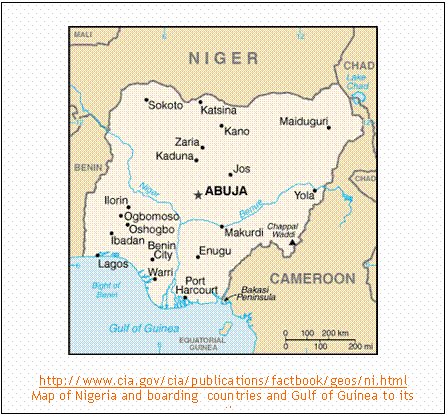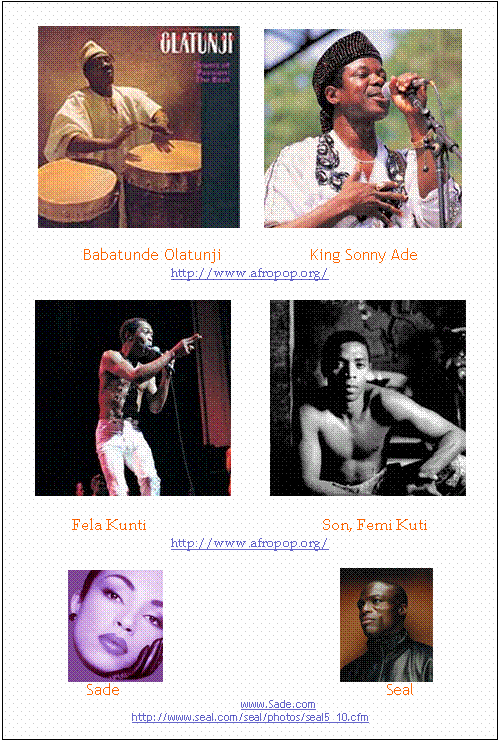Born to be King Sankofa Oyafunmike Nigeria
Word to
the Wise Poetry Exchange Advertisements
By Osaremi
O. Lanloke & Ayoka A.
Lanloke
Nigeria, or officially , the Federal Republic of Nigeria is
the most  populace Black country in the world with more than 133
million people, more than 250 languages and 25 different ethic groups, the
largest being the Hausa and Fulani (29%), the Yoruba (21%), the Igbo (18%) and Kanurei (4%). Located in west Africa’s Gold coast, Nigeria
is surrounded by Benin to the west, Niger to its north, Chad to its northeast,
Cameroon to its east, and Gulf of Guinea to its south. Formerly,
populace Black country in the world with more than 133
million people, more than 250 languages and 25 different ethic groups, the
largest being the Hausa and Fulani (29%), the Yoruba (21%), the Igbo (18%) and Kanurei (4%). Located in west Africa’s Gold coast, Nigeria
is surrounded by Benin to the west, Niger to its north, Chad to its northeast,
Cameroon to its east, and Gulf of Guinea to its south. Formerly,
 By 1700 , the British were the
leading slave traders in the region. In 1861,
By 1700 , the British were the
leading slave traders in the region. In 1861,
Many Nigerians are moving away from rural areas to find
jobs. Overcrowding and pollution are
becoming a major concern in the cities. Some of the morals, tradition and
culture are being lost. Formerly, over
eighty percent of the population in
Polygamy is practiced by some families. Wives enjoyed the friendships and sharing of the
workload. “All work is better in company” is a popular Nigerian saying. A woman
who is unhappy in her marriage can go back to her own family. . Duty to family
is very important. Large extended families are prevalent and marriage not only
include obligations to two people but also their extended family. In
some parts of the country it is still customary for the man to pay a “dowry” to the family of the bride and/or
help pay for the education and funeral expenses of immediate and distant
relatives if he can afford it.
Nigerians are also noted for their hospitality and to invite
strangers into their homes for a meal or a place to stay. Guest are offered
kola nut. This is a sign of friendship and welcome.
Nigerian artists have created works for centuries. They are especially
noted for their terra-cotta clay heads created by Nok
sculptors around 500 B. C. Artists
were using clay, wood and bronze as well
as metal by the l300’s. Art was used in everyday life, religious ceremonies and
were used not only for its beauty but also for a purpose. Present day Nigerian
artists sill create wood carvings, pottery, leather crafts, hand woven
fabrics, sculptures and jewelry
which are sold around the world.
Nigerian musical artists have been acclaimed all over the
world. The late Babatunde Olatunji’s
born in  of Passion. In 1950, Olatunji
came to
of Passion. In 1950, Olatunji
came to
Nigerians enjoy a variety of sports and leisure
activities. Competitions in hunting,
wrestling, archery, track, fishing, canoeing, swimming and horse racing were
common in the past Other modern sports include tennis, golf, hockey, pool,
boxing and basketball. Akin Olajuwon is a well-known
basketball player here in the
Nigerian foods have also been introduced as they have
traveled throughout the world and people have visited
Recipes
Serves
Ingredients
3 pounds goat meat (optionally, fish or beef)
1 cup dried crayfish*
2 cups melon seed, ground*
1 teaspoon dried red pepper, ground or crushed
2 tablespoons salt
1 medium onion, chopped
3 tablespoons red palm oil*
bitterleaf*, chopped (optionally, spinach or kale)
7 cups water
Equipment
skillet
mortar and pestle, blender or food processor
knife
large spoon for stirring
cutting board
Preparation
- Cut meat in small pieces and place in
skillet
- Combine with water, onion, salt and
boil for 15 to 20 minutes
- Add ground melon seed and remaining ingredients,
stirring as added
- Cook for 10 more minutes, and serve
with eba/gari,
(mashed or fried grated cassava), Inyan
(pounded yam), or pounded cassava.
http://www.folklife.si.edu/vfest/africa/recipes.htm
moyin-moyin
Non-detailed
instructions:
![]() Prepare foil or empty cans for the cooking:
Prepare foil or empty cans for the cooking:
![]() If using empty cans, make sure their interior is clean, and
lightly greased.
If using empty cans, make sure their interior is clean, and
lightly greased.
![]() If using foil:
If using foil:
![]() Tear off about 1 foot of the foil.
Tear off about 1 foot of the foil.
![]() Fold the foil in half.
Fold the foil in half.
![]() One of the edges is closed and fine. For two of the other
edges, roll them a few times over to make sure they will take the weight of the
mixture (at least an inch-worth of rolling).
One of the edges is closed and fine. For two of the other
edges, roll them a few times over to make sure they will take the weight of the
mixture (at least an inch-worth of rolling).
![]() When you are done, the foil will look like rectangles with
only one edge open.
When you are done, the foil will look like rectangles with
only one edge open.
![]() Soak some beans in a large container (some people recommend
lightly grounding the beans first to make it easier to remove the skin) for
about an hour or so.
Soak some beans in a large container (some people recommend
lightly grounding the beans first to make it easier to remove the skin) for
about an hour or so.
![]() Rub the beans between your hands to peel the skin off. (The
skin should float to the top of the container.) Keep doing this until you have
most of the skin off the beans.
Rub the beans between your hands to peel the skin off. (The
skin should float to the top of the container.) Keep doing this until you have
most of the skin off the beans.
![]() Grind the beans into a smooth, finely-ground, mostly-liquid
paste.
Grind the beans into a smooth, finely-ground, mostly-liquid
paste.
![]() Add blended tomatoes (or tomato sauce and paste), oil (just a
few teaspoons), a little salt, and if you wish, you can also add hard-boiled
eggs, or dried fish, or meat, or ground beef.
Add blended tomatoes (or tomato sauce and paste), oil (just a
few teaspoons), a little salt, and if you wish, you can also add hard-boiled
eggs, or dried fish, or meat, or ground beef.
![]() Place into either the foil or the cans.
Place into either the foil or the cans.
![]() If using cans, simply pour some of the batter into the cans,
making sure you leave enough room for the cooking moyin-moyin
to rise.
If using cans, simply pour some of the batter into the cans,
making sure you leave enough room for the cooking moyin-moyin
to rise.
![]() If using foil, pour some of the batter into the foil, and
then close up the last edge of the foil (once again, by rolling it securely).
If using foil, pour some of the batter into the foil, and
then close up the last edge of the foil (once again, by rolling it securely).
![]() Place some water in a large pot.
Place some water in a large pot.
![]() Place the cans or the foil into them.
Place the cans or the foil into them.
![]() Boil the moyin-moyin until it forms
a solid substance (at least half an hour)
Boil the moyin-moyin until it forms
a solid substance (at least half an hour)
![]() Remove them from the cans or the foil before serving.
Remove them from the cans or the foil before serving.
![]() Usually eaten with rice, meat, and maybe other sides.
Usually eaten with rice, meat, and maybe other sides.
http://www.motherlandnigeria.com/recipes.html
Reference:
Dejo, F.
(1975). Oral traditions. Lagos Nigeria Wanda
Abimbola editor.
Levy, P.
(1993). Cultures of the World:
Mbiti, J. (1969) African
Religions and Philosophy.
Moore, F. (1970). Sociology of the Yoruba. Ibadan, Nigeria, Ibadan University Press
CIA - World Fact book (no date). [Online]
Available: www.cia.gov/cia/publications/factbook/geos/ni.html
Afro Pop Worldwide (2001-2003). [Online] Available: www.Afropop.org